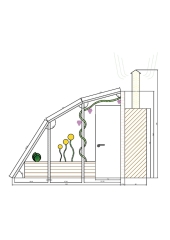posted 13 years ago
Here is one big drawing:
It is too big for this page, so I invite you to look at it using the link.
http://www.ernieanderica.info/rocketmassheaterpermitting/RocketHeater6in20000.jpg
I will write as simply as I can. Maybe Henry can translate this instead of the book (it's shorter).
Important things to notice:
- All the pipes and inside spaces are about the same size (shown in blue). If the gas can't flow through these openings because they are too small, there will be smoke problems. We hate smoke inside the house.
- There is insulation all around where the fire burns. This insulation is usually perlite (foamy rock, used for garden soil). Insulation can also be made with sawdust and clay, or wood ash. The insulation helps the fire inside get very hot, like a furnace (kiln) ... so very hot that inside, the materials might start to glow. Use brick or good materials inside the burn (combustion) area.
- There is a tall 'chimney' that goes up inside the barrel. We call this inside chimney the 'heat riser' because this is where the heat rises. This is what makes the heater work.
The heat riser is part of the burn area. It must be much taller than the fuel opening - about 3 times taller.
- The fuel goes in the opening in front, and then the fire burns sideways before going up. The sideways part must not be too long - only half as long as the heat riser.
- After it is done burning inside the chimney, there is almost no smoke. The exhaust is mostly hot steam (fog) and CO2 (gas that makes bubbles in beer). So we call it 'exhaust' not 'smoke.' If it makes smoke, something is not right.
(Even if it is all working right, do not drink it. It is not beer or water, still wood exhaust.)
- The metal barrel is raised above the heat riser, with a gap about 2 inches tall (5 cm).
The hot exhaust makes the barrel hot like a metal woodstove. It gives (radiates) lots of heat for you to enjoy. As the exhaust releases heat, it goes down. Hottest exhaust is at the top, it gets cooler toward the bottom. (Warm like a bread oven - still hot, but not like a furnace.)
- After the barrel, the warm exhaust must find the other pipes. Make sure the opening is big enough. (not shown). It must be at least as big as the pipes. The barrel and opening are the only place where it is good to have a much larger space than the pipes.
- The pipes are usually horizontal. The slope is not too important, and it is OK to make several bends, but try not to go more than a few feet up or down. We like to make a bench or bed so you can have a warm seat. You may want a big one, or two separate sides, so all the dogs have a warm place too.
In the drawing, the pipes are made from ducting. You can also make a tunnel of brick, adobe, concrete drainpipe, clay pipe, or anything that is easy to shape and easy to clean. It must be the proper size on the INSIDE.
- It is good to have places to clean out the ashes. Ash falls inside the barrel, and a little in the other pipes. We clean where the firewood goes about every 2 weeks, and clean the other parts once each year.
- Around these pipes, we put a lot of earthen masonry (the mixture of sand and clay that Ernie told you about) and sometimes bricks or rock. These are to hold the heat. With 4 or 6 inches of masonry around the pipes, the bench will hold heat for 12 to 24 hours. More masonry means more heat storage.
- After it goes through the bench, the exhaust is only warm (like a cat). It must go outside of the house for safety - it can go sideways, horizontally, through a wall. Or it can go up vertically like a woodstove, through the roof. Going up inside the house and out the roof gives best draft if the wind likes to change directions. Going out sideways works OK if the wind is always one way, you can put the exhaust out on the downwind (lee) side of the house.
It is a lot to understand, but I tried to use words that are easy to look up using an Internet dictionary.
If you understand, you can build something like the picture, and it should work.
The most important part to practice outdoors is the combustion part - you should be able to put the barrel on, and see only steam coming out below.
To light the fire, first put a little paper or tinder in the tunnel, until you see the flames point away from you, toward the heat riser. Make a loose twist of paper (do not fill the whole box, leave room for air), light one end on fire and push it inside the tunnel, and put the small kindling right on top of the not-yet-burning end. It might take more than one try - make lots of small kindling or twigs. All sticks can be loaded in vertically (up and down). They will burn at the front and bottom first, and the rest will drop down and keep burning for a good, long time. Sometimes people also put charcoal or other fuel in, after the fire is burning and happy.
You can cook on top of the barrel.
Before building inside the house, burn the paint off the barrel. You can do this simply by building a good fire inside it, outdoors. Sand or a wire brush can help take the last paint off. After it is scrubbed very clean, and you build the stove, you can oil the top and fry things, or put a teakettle or steam cooker on top.
Good luck with your project. I hope you are warm soon.
I like the pictures of your dogs by the fire - I want to see pictures when you build the new heater too.
Yours,
Erica Wisner

 1
1




 1
1




 1
1





 1
1





 1
1




 1
1




 1
1




 1
1




 1
1




 1
1




 1
1





 1
1




 1
1




 1
1








